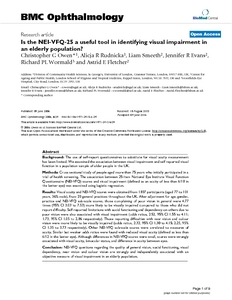Owen, CG; Rudnicka, AR; Smeeth, L; Evans, JR; Wormald, RP; Fletcher, AE
(2006)
Is the NEI-VFQ-25 a useful tool in identifying visual impairment in an elderly population?
BMC Ophthalmology, 6 (24).
-.
ISSN 1471-2415
https://doi.org/10.1186/1471-2415-6-24
SGUL Authors: Owen, Christopher Grant Rudnicka, Alicja Regina
![[img]](https://openaccess.sgul.ac.uk/2456/1.hassmallThumbnailVersion/1471-2415-6-24.pdf)  Preview |
|
["document_typename_application/pdf; charset=binary" not defined]
Published Version
Download (261kB)
| Preview
|
Abstract
BACKGROUND: The use of self-report questionnaires to substitute for visual acuity measurement has been limited. We examined the association between visual impairment and self reported visual function in a population sample of older people in the UK.
METHODS: Cross sectional study of people aged more than 75 years who initially participated in a trial of health screening. The association between 25-item National Eye Institute Visual Function Questionnaire (NEI-VFQ) scores and visual impairment (defined as an acuity of less than 6/18 in the better eye) was examined using logistic regression.
RESULTS: Visual acuity and NEI-VFQ scores were obtained from 1807 participants (aged 77 to 101 years, 36% male), from 20 general practices throughout the UK. After adjustment for age, gender, practice and NEI-VFQ sub-scale scores, those complaining of poor vision in general were 4.77 times (95% CI 3.03 to 7.53) more likely to be visually impaired compared to those who did not report difficulty. Self-reported limitations with social functioning and dependency on others due to poor vision were also associated with visual impairment (odds ratios, 2.52, 95% CI 1.55 to 4.11; 1.73, 95% CI 1.05 to 2.86 respectively). Those reporting difficulties with near vision and colour vision were more likely to be visually impaired (odds ratios, 2.32, 95% CI 1.30 to 4.15; 2.25, 95% CI 1.35 to 3.73 respectively). Other NEI-VFQ sub-scale scores were unrelated to measures of acuity. Similar but weaker odds ratios were found with reduced visual acuity (defined as less than 6/12 in the better eye). Although differences in NEI-VFQ scores were small, scores were strongly associated with visual acuity, binocular status, and difference in acuity between eyes.
CONCLUSION: NEI-VFQ questions regarding the quality of general vision, social functioning, visual dependency, near vision and colour vision are strongly and independently associated with an objective measure of visual impairment in an elderly population.
| Item Type: |
Article
|
| Additional Information: |
PMCID: PMC1523367
© 2006 Owen et al; licensee BioMed Central Ltd.
This is an Open Access article distributed under the terms of the Creative Commons Attribution License (http://creativecommons.org/licenses/by/2.0), which permits unrestricted use, distribution, and reproduction in any medium, provided the original work is properly cited. |
| Keywords: |
Aged, Aged, 80 and over, Color Vision Defects, Cross-Sectional Studies, Dependency (Psychology), Geriatric Assessment, Humans, Interpersonal Relations, National Institutes of Health (U.S.), Questionnaires, United States, Vision Disorders, Vision, Binocular, Visual Acuity |
| SGUL Research Institute / Research Centre: |
Academic Structure > Population Health Research Institute (INPH) |
| Journal or Publication Title: |
BMC Ophthalmology |
| ISSN: |
1471-2415 |
| Dates: |
| Date | Event |
|---|
| 9 June 2006 | Published |
|
| PubMed ID: |
16764714 |
| Web of Science ID: |
16764714 |
  |
Download EPMC Full text (PDF)
|
 |
Download EPMC Full text (HTML)
|
 |
Go to PubMed abstract |
| URI: |
https://openaccess.sgul.ac.uk/id/eprint/2456 |
| Publisher's version: |
https://doi.org/10.1186/1471-2415-6-24 |
Statistics
Item downloaded times since 01 May 2012.
Actions (login required)
 |
Edit Item |




